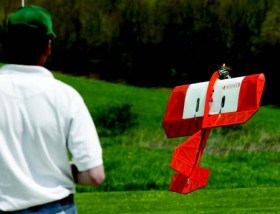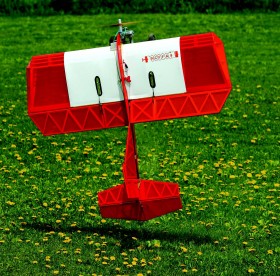I am really glad to be writing this new column and especially to be a contributor to Fly RC Magazine! This magazine is going to be the place to discover and learn about the best and coolest gear, and this column is where you will learn to sharpen your piloting skills! It is a special interest group within the AMA that is dedicated to hyper maneuverable flight and pitting you and your plane against the stopwatch! If you have ever considered yourself a hot pilot, show up at one of their contests and prepare to be amazed. Check them out at www.ncffafunfly.org
HOVERING
What is the attraction to hanging your plane on its nose and holding it motionless and in full control? Simple answer, it’s cool! I am going to explore the phenomenon, the kinds of planes that hover best and what you need to know to teach yourself this great flying skill.

PLANES, ENGINES AND PROPS
The most important aspect of your selecting a plane to hover is its weight. Your plane must be light. Secondly, you need to have substantial control surfaces on the rudder, elevator and ailerons that are in the prop blast of the engine. Planes that have ailerons only on the outboard section of the wing are unsuitable, because with no airflow over the ailerons, there is no control in hover no matter how far you deflect them!
I have found that planes with longer fuselages, while more stable in pitch, are not necessarily good for hovering. This is because the rudder and elevator are too far from the slipstream of the prop. You need a strong slipstream over the tail feathers for control.
There are several ways to improve an airplane’s ability to hover. One is to move the CG aft incrementally—a little at time so that you can test the result. An aft CG helps a lot in the transition from normal flight to hover and back, but use care, as you do not want to go so far that you give up your stability in normal flight! Another concern is flaperons that are coupled to the elevator. While this gives the tightest loops on most fun-fly planes, it does not help in hovering. In hover, flap deflection on most models sends the plane in the opposite direction (in pitch) than you desire. I advise that you turn off this function, or turn it down so less than 10 percent of flap throw is mixed into elevator throw.
THRUST TO WEIGHT RATIO
The engine must be able to lift the plane vertically, which is a combination of propeller selection and fuel. You need a power to weight ratio of at least 1.5 to 1. We do not want to hover at full throttle, we want to ideally hover at half throttle. We need the reserve power because we are vectoring propwash off the ailerons to generate the high degree of roll, and this robs lift and requires the increase in throttle. A high speed torque roll requires the most power, in the order of 2:1 just to maintain altitude! Suffice to say that this is a very advanced hovering maneuver! You need a very reliable engine. Hovering is great until the noise stops!
Do not use an engine that has a history of running hot or lean. On the average .40 powered ship, look to configure your plane with a “heli-like” setup. By this I mean, choose a prop with the biggest diameter and lowest pitch which will function with the landing gear and flight envelope of your plane. I have found that the 11×4 prop is outstanding for hovering with most .40 powered planes. The engines swing it easily, (you do not want to over heat), and the four inch pitch generates gobs of thrust at lower flight speeds.
Fuel selection is important. Since we are trying to hover at half of our available throttle, consider using a higher nitro fuel. The more nitro, the cooler the engine runs. This is because the nitro brings more oxygen into the engine and this is where the power boost and substantial cooling takes place. High Nitro causes harm when you are at high throttle settings and at rpm’s that overcome the cooling effects of the nitromethane.

FLYING
You might think that heli experience is helpful, but there are conflicts with that logic. When you stand your plane on its tail, the yaw axis is controlled by your ailerons, not the rudder. The rudder, (left stick) controls the roll axis! Heli pilots need to teach their fingers some new tricks or they will find themselves in trouble!
The throttle, of course, is no longer fast and slow, it is now for rising and decending. There is no “chopping the throttle” when you get in trouble here! Try that, and you will find that tail first impacts break things on your plane that you have never seen broken before.
Start with transitioning to hover by practicing holding higher and higher angles of attack and learning how much throttle to add to compensate for the lost lift, no longer generated by the wings. As you pass through the 45 degree angle point, you will find that your speed drops almost to zero very quickly. You’ll need the most right rudder at around 45 degrees. As you approach vertical, you’ll find that most planes still want some right rudder, even when hanging vertically. I believe this has more to do with countering torque than any other factor, whereas the rudder compensation at the 45 degree angle is almost all due to “P” factor. (more on “P” factor in a future column).
If your plane needs too much throttle to make the transition and you constantly end up gaining altitude in order to get the plane into the vertical position, this suggests that you are nose heavy, or lacking in elevator authority needed to swing the tail under the plane. Running the CG aft of the recommended area is tricky business, but it can make all the difference in a stable transition. Practice is the key, but keep a careful eye on the fuel tank and the air/fuel mixture feeding the engine. You can’t afford for the engine to go lean now!
Flying into and out of a stable hover requires power. If your plane does not have a low wing loading, you may find that it belly flops when you go to exit the hover. This is due to the rapid transition back to “wing-borne” flight—this transition may leave you at such a low airspeed that the wings won’t to hold the plane up. Expect that the plane will need a boost of power to get it back to “horizontal” flying speed! Give it this boost just as it starts to pitch over.
Like your first landings, a quality performance takes practice. Start a bit on the high side to see how your plane behaves and stick with it. Soon you will be hanging in space. One thing that hovering teaches you is to be a master of your left hand!
Good Luck-Dave Baron
 Fly RC Magazine WE LIVE RC
Fly RC Magazine WE LIVE RC
